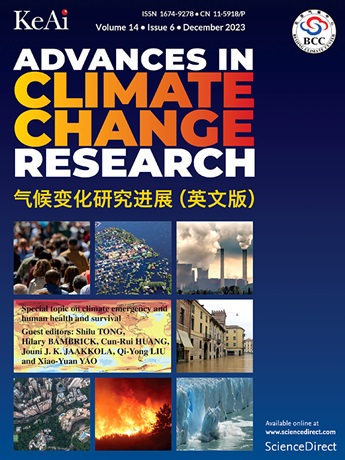Uncertainties in global permafrost area extent estimates from different methods
IF 5.2
1区 地球科学
Q1 ENVIRONMENTAL SCIENCES
引用次数: 0
Abstract
Previous permafrost extent estimates applied one or two methods to calculate the permafrost area, and the uncertainties between the methods were not assessed. Here, we apply seven methods to estimate and project global permafrost area extent and discuss the uncertainties of each approach. These methods are forced with output from CMIP6 and ERA5-Land, and we quantify the seven methods’ differences and uncertainties. During the historical period (1981–2010), the mean global permafrost area from multiple methods is 14.1 ± 4.5 × 106 km2, with differences ranging from 2.1% to 31.2%. The variability in future permafrost area extent degradation relative to the historical period based on different methods ranges from 1.8% to 34.7%. Uncertainties in permafrost area extent estimates can reach 35% based on different methods. Under various future emission pathways (e.g., SSP1-2.6, SSP2-4.5, SSP3-7.0, and SSP5-8.5), the worst-case scenario (SSP5-8.5) projects a permafrost extent of only 1.3–8.2 × 106 km2 for 2070–2099, corresponding to area decreases of 51.2%–86.9%. Spatially, permafrost near the lower-latitude permafrost boundary may completely disappear by the end of the 21st century, while degradation in the circum-Arctic, Qinghai–Tibet Plateau, and Antarctica will be smaller, but still exceed 50% under the highest emission scenario (SSP5-8.5). Compared to the temperature distribution of existing permafrost maps, the temperature at top of permafrost model and the surface frost index using ground temperature adjusted for snow methods perform best. However, compared to in-situ boreholes, two generalized linear model approaches have the best overall accuracy. These uncertainties using different methods are important to recognize in assessments of the future state of permafrost degradation.
不同方法估算全球永久冻土区范围的不确定性
以往的多年冻土范围估计采用一种或两种方法来计算多年冻土面积,并且没有评估方法之间的不确定性。本文采用7种方法估算和预测全球多年冻土区面积,并讨论了每种方法的不确定性。将这些方法与CMIP6和ERA5-Land的结果进行对比,量化了7种方法的差异和不确定性。在历史时期(1981—2010年),多种方法估算的全球多年冻土区平均面积为14.1±4.5 × 106 km2,差异在2.1% ~ 31.2%之间。基于不同方法的未来多年冻土区面积退化相对于历史时期的变率在1.8% ~ 34.7%之间。基于不同的估算方法,冻土面积估算的不确定性可达35%。在不同的排放路径下(如SSP1-2.6、SSP2-4.5、SSP3-7.0和SSP5-8.5),最坏情景(SSP5-8.5)预估2070-2099年冻土面积仅为1.3-8.2 × 106 km2,面积减少51.2%-86.9%。从空间上看,在最高排放情景(SSP5-8.5)下,低纬永久冻土边界附近的永久冻土可能在21世纪末完全消失,而环北极、青藏高原和南极洲的退化幅度较小,但仍超过50%。与现有多年冻土图的温度分布相比,多年冻土模型的顶部温度和使用地温调整雪法的地表霜指数表现最好。然而,与原位钻孔相比,两种广义线性模型方法具有最好的整体精度。在评估永久冻土退化的未来状态时,重要的是要认识到使用不同方法的这些不确定性。
本文章由计算机程序翻译,如有差异,请以英文原文为准。
求助全文
约1分钟内获得全文
求助全文
来源期刊

Advances in Climate Change Research
Earth and Planetary Sciences-Atmospheric Science
CiteScore
9.80
自引率
4.10%
发文量
424
审稿时长
107 days
期刊介绍:
Advances in Climate Change Research publishes scientific research and analyses on climate change and the interactions of climate change with society. This journal encompasses basic science and economic, social, and policy research, including studies on mitigation and adaptation to climate change.
Advances in Climate Change Research attempts to promote research in climate change and provide an impetus for the application of research achievements in numerous aspects, such as socioeconomic sustainable development, responses to the adaptation and mitigation of climate change, diplomatic negotiations of climate and environment policies, and the protection and exploitation of natural resources.
 求助内容:
求助内容: 应助结果提醒方式:
应助结果提醒方式:


